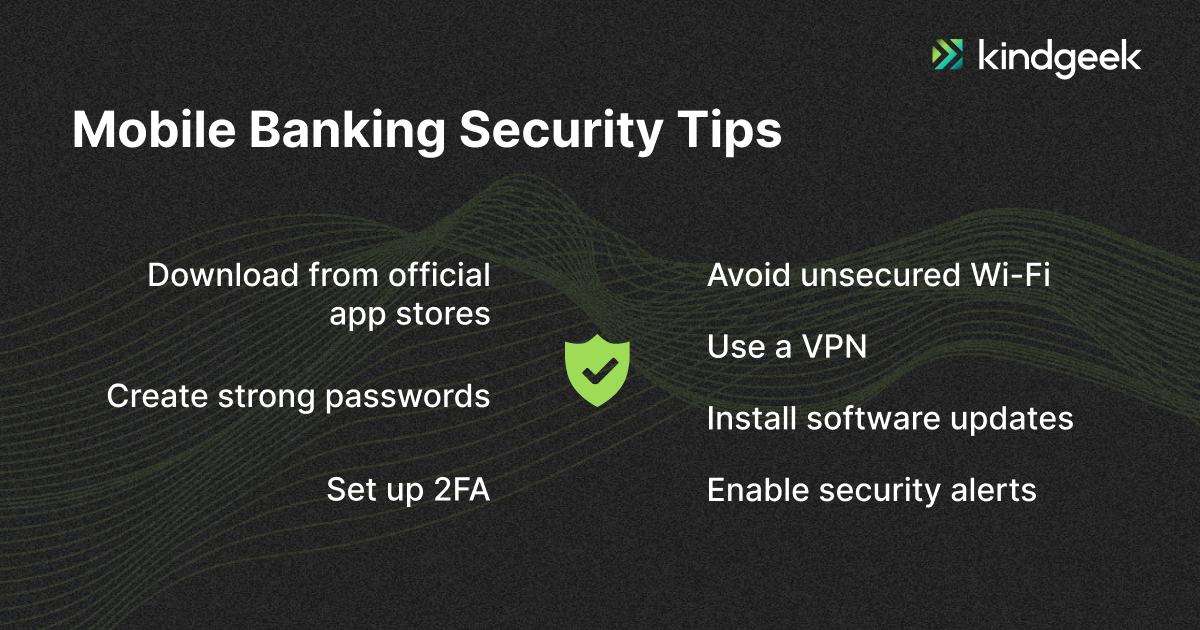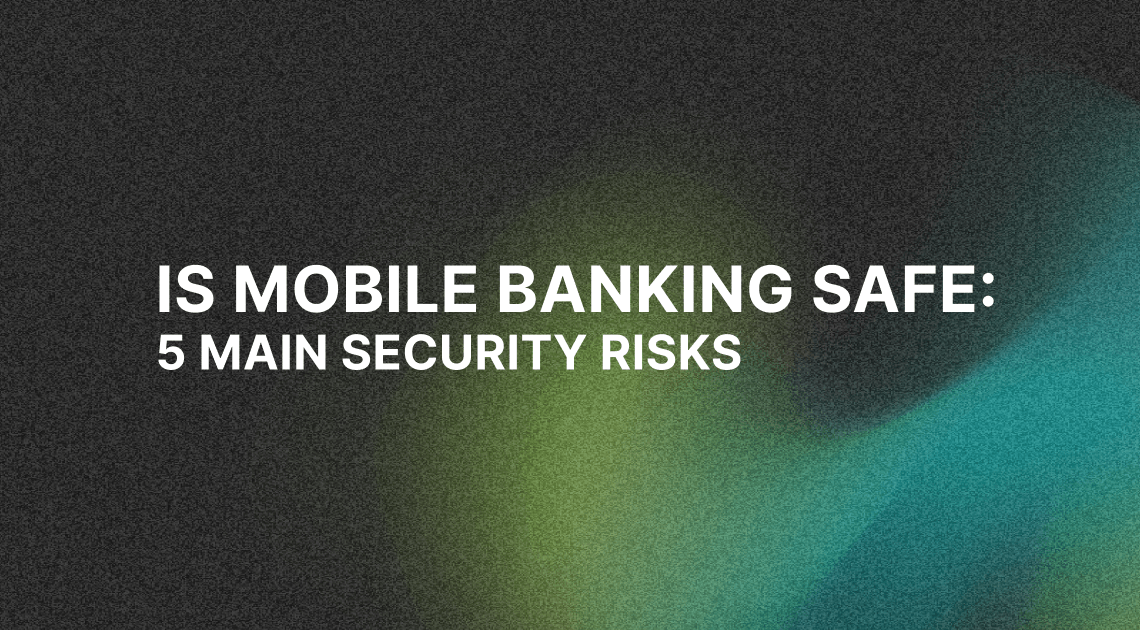Recently updated on July 22, 2024
In the article on personal finance apps, we said that overt repetition about security in fintech is justified and that we had talked and would talk about it again. Clearly, mobile banking and security must always go hand in hand.
As more and more users are going for convenience, they are choosing their phones to handle financial matters. With a few swipes and taps, you can send money and monitor expenses from virtually anywhere, anytime.
However, within this transformative landscape, security remains a delicate matter. This is particularly evident now when mobile banking risks go beyond physical phone theft and unreliable passwords. The rise of sophisticated cyber threats demands quick and effective solutions.
So, this article is intended to provide strategic clarity on navigating and fortifying mobile security for banking apps. We will share key security risks and best practices to ensure a safe experience.
Content:
- Recognizing Security Risk
- Common Mobile Banking Security Risks
- Key Strategies for Secure Mobile Banking Experience
- Final Thoughts
Recognizing Security Risks
When considering the question, “How secure is mobile banking?”, it’s important to understand the potential threats to the confidentiality, integrity, and safety of users’ financial data and transactions. While mobile banking offers more security than online banking via a browser, it still poses security risks. Let’s say, your bank or its app gets breached. In such cases, hackers could gain access to sensitive financial information contributing to concerns amid a surge in cybersecurity breaches.
According to the Nokia Threat Intelligence Report 2023, banking trojans were among over one-third (35%) of detected malware attacks on mobile networks along with ad-click bots and crypto-miners.
The consequences of security threats in mobile banking can be severe for users. They can lead to financial losses, identity theft, and the need for recovery efforts on top of emotional distress. That’s why a security-first approach to development is so important to fintech applications.
Common Mobile Banking Security Risks
Anyone can benefit greatly from being aware of and taking precautions against certain security threats in mobile banking. Stay alert — explore these potential dangers:

Wi-Fi Hacking
Is mobile banking safe while you’re connected to a public Wi-Fi network? Most likely, no. It leaves you vulnerable to possible man-in-the-middle attacks (Wi-Fi hacking). In an MITM attack, an attacker intercepts communication between your mobile device and a bank server. They can gain unauthorized access to your accounts, steal personal information, and even alter the data transmitted.
If the data is not encrypted, sensitive information can be easily accessed. For this reason, you should consider using Virtual Private Network (VPN) to encrypt your internet traffic while using unsecured Wi-Fi hotspots.
Phishing Attacks
Scammers can send fraudulent messages, usually emails, pretending to represent a legitimate bank. These messages typically contain links to fake websites that ask users to confirm their login credentials and credit card details. In a worst-case scenario, clicking on these links may infect your device with malware that allows hackers to access your banking app.
Data from the Anti-Phishing Working Group (AWPG) shows that 2023 set a record for phishing attacks, with 5 million unique phishing sites. However, the first quarter of 2024 showed more positive stats. The APWG report observed 963,994 phishing attacks, the lowest quarterly total since the end of 2021. The banking sector, in particular, saw a 9.8% drop in phishing scam incidents.
Data Breaches
If a financial institution experiences a security breach, stolen data can be used for identity theft, fraud, and related damage. This puts countless users at risk.
According to IBM’s research, the average cost of a data breach in 2023 reached an all-time high of $4.45M globally. As a result, more organizations plan to increase investments in their mobile banking security policy including incident management, employee training, and threat detection tools.
Fake Mobile Banking Apps
Knowing what you download on your phone is another important thing. Fake banking apps are a significant security threat as they mimic legitimate banking apps, often using similar icons, names, and user interfaces. This tricks users into downloading them and divulging personal and financial information.
Despite the efforts of app store gatekeepers to screen and remove malicious apps, some fake banking apps manage to slip through the cracks. That’s why, apart from only downloading apps from real app stores, it’s also imperative to take the time to verify their authenticity by researching the developer.
Banking Malware
Malware can take on many forms, from viruses to sophisticated software designed specifically to target mobile app users. Here are some of the most common types of malware that pose threats to banking apps:
- Trojan pop-up overlays. Malicious programs known as “trojans” can overlay reputable banking app interfaces with phony pop-up windows. When users enter their credentials into these seemingly authentic overlays, the information is sent directly to attackers.
- “Keylogging” malware. This is a type of spyware that records every keystroke a user makes on their mobile device. Anything you type in, from passwords to messages, can be secretly captured if you download a keylogger-infected app.
- Ransomware. Ransomware can block customers from using their banking apps and demand money to allow them to access again. Sensitive data may be jeopardized even if the ransom is paid; access cannot be guaranteed to be restored.
Certain attacks can combine several forms of malware, amplifying the threat. An example of this is a new Android Banking Trojan, “Antidot,” which masquerades as a Google Play update application and integrates overlay attacks with keylogging features.
Key Strategies for Secure Mobile Banking Experience
Now that we’ve cleared the common risks, let’s talk about mobile banking security solutions.

Download apps from official stores
Always download banking apps from the official app stores like Google Play Store for Android or Apple App Store for iOS. Before downloading, make sure to verify the developer, read reviews and ratings, and check app permissions. Use the direct links to the app store offered on your bank’s official website.
Set strong passwords and 2FA
Create complex passwords with a mix of special characters, numbers, and letters. Don’t use information that can be guessed, such as birthdays or pet names.
Turn on two-factor authentication (2FA) for another layer of protection. This entails receiving a code through SMS, email, or an authenticator app.
Avoid public Wi-Fi
Because public Wi-Fi networks are frequently unprotected, hackers can more easily intercept your data. Refrain from using public Wi-Fi to access your banking app or make any financial transactions. If necessary, use a VPN to secure your connection.
Install software updates
Update your device’s operating system and apps to the most recent versions. Updates often contain security fixes from recently identified vulnerabilities.
Enable security alerts
Enable security alerts from your banking app. These alerts can notify you of any suspicious activities, such as unusual login attempts or transactions.
To be informed about any odd activity or changes to your credit report, you can also consider signing up for credit monitoring services. This might assist you in reacting to possible fraud right away.
Final Thoughts
Unfortunately, there is no such thing as a perfectly secure mobile bank because as security practices improve so do crafty methods of undermining security and overcoming protective measures. There’s no evolution without threats.
The closer you get to the ideal of a well-protected fintech app that meets banking regulations and features data encryption, multi-factor authentication, and fraud detection, the less likely the product will fall prey to hacks, strange bugs, and unpredictable circumstances. Also, continuous updates are absolutely necessary for sufficient security.
In the end, the mobile security for banking apps comes down to a team responsible for the development. If you own a fintech product and are unsure about its safety, consider Kindgeek cybersecurity services. We can provide you with thorough consulting services or assist you in creating a system that is well-protected from the ground up.
We also provide our own products, such as a white label banking platform, which serves as a foundation for digital finance products. The customizable white-label core allows you to build on top of it and create a unique customer experience. No need to start from scratch — go to market quickly, cost-effectively, and most importantly, safely.




